
100 Bay Street
Sausalito, CA, US, 94965
Tel:415-331-6200
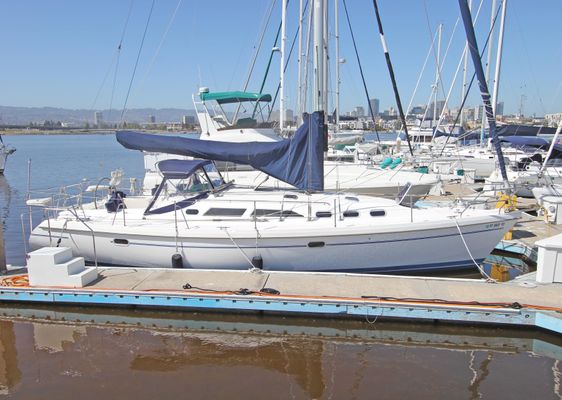
2000 Catalina 380
In awarding the Catalina 380 a Boat of the Year Award (Best Value, Midsize Cruiser) in 1997, Cruising World noted, "When one of the biggest production sailboat builders in the world corrals top honors in a no-holds-barred fleet of extremely able contenders — including some candidates that fetch tens of thousands of dollars more — it's time to take serious notice" (click on FULL SPECS above for copy of that article, as well as an article about Catalina from Professional Boatbuilder magazine).
The Catalina 380 is a big boat--she's actually 38'5 LOA, almost a foot longer than 38-footers built by her competitors.The design has only grown in popularity in the ensuing years, and IO is one of the finest examples you're ever going to find.
First off, she shows practically as new inside and out. And she's a deep draft model fitted with the conventional full batten main, which a lot of sailors prefer for the typically boisterous Bay conditions (but they're just becoming harder and harder to find as everyone switches to in-mast systems). AND very low time (barely 600 hours!) on the Westerbeke diesel, new (June, 2022) custom heavy duty offshore dodger, new batteries (also in 2022). Schaeffer roller furler head sail, top of the line deck hardware and electronics, centerline queen in full beam master stateroom (which also has an in-suite head), the galley stove looks like it's never been used.
She's also one of the few late model sailboats around this size for sale in the Bay Area right now PERIOD and should be considered a must see if you're in the market.
Specifications
Engine 1 Specifications
Media Gallery
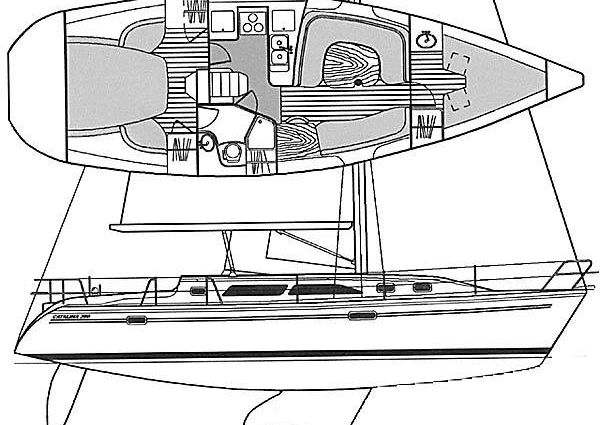 |
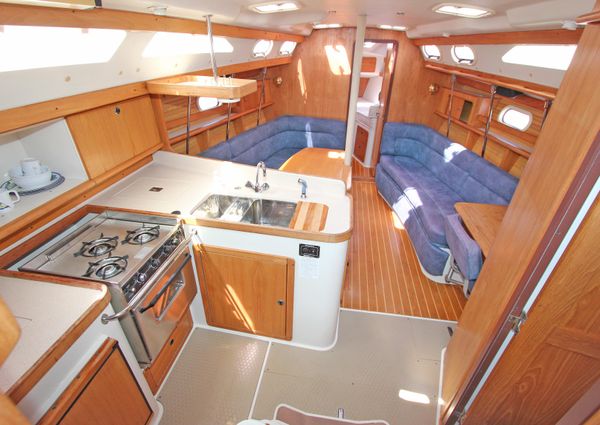 |
 |
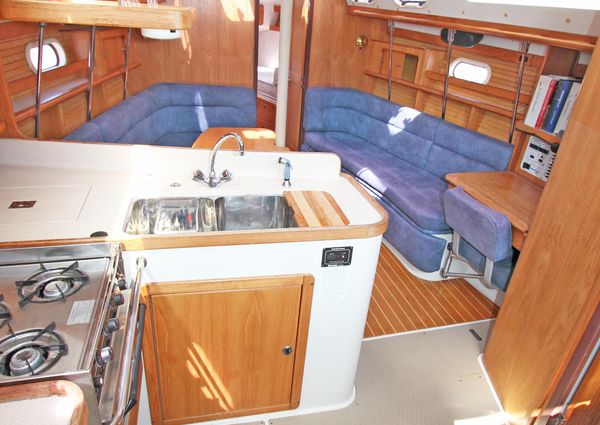 |
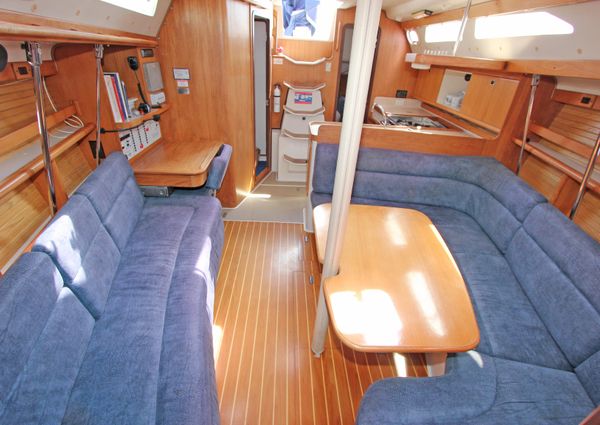 |
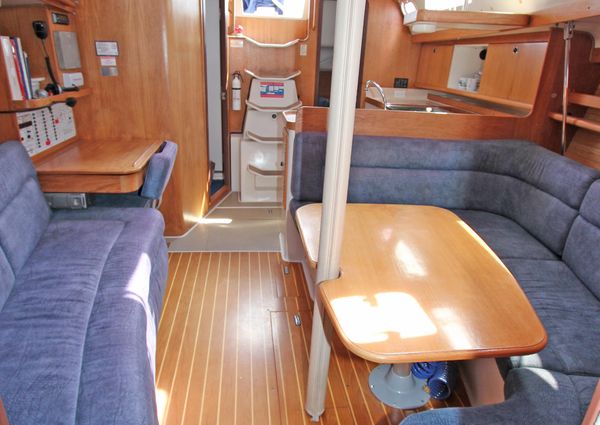 |
 |
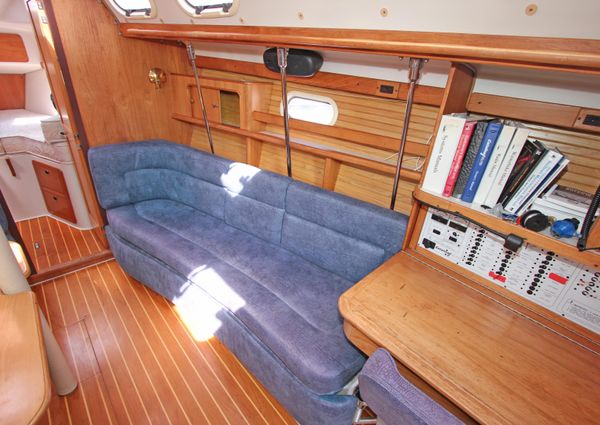 |
 |
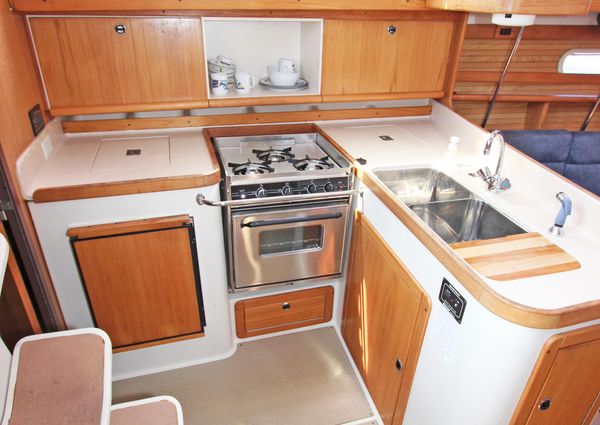 |
 |
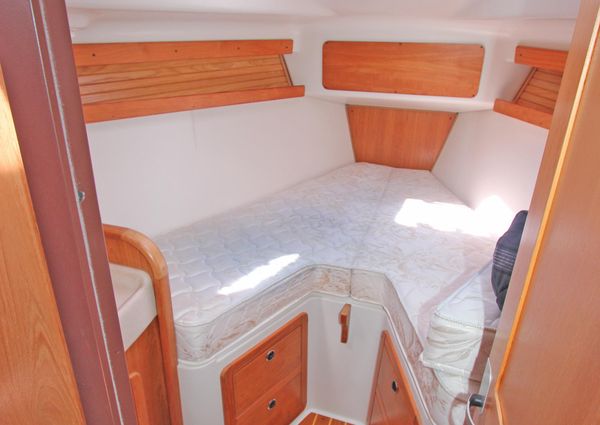 |
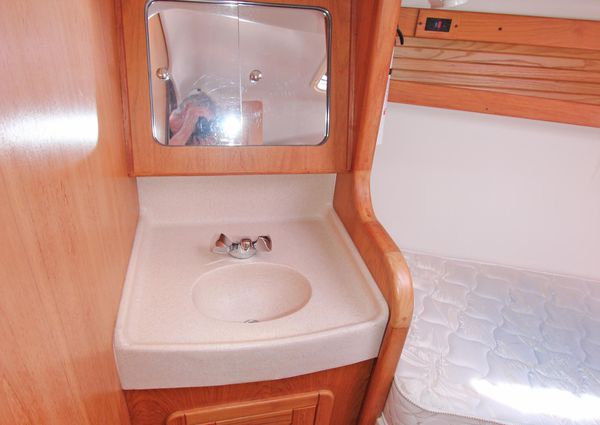 |
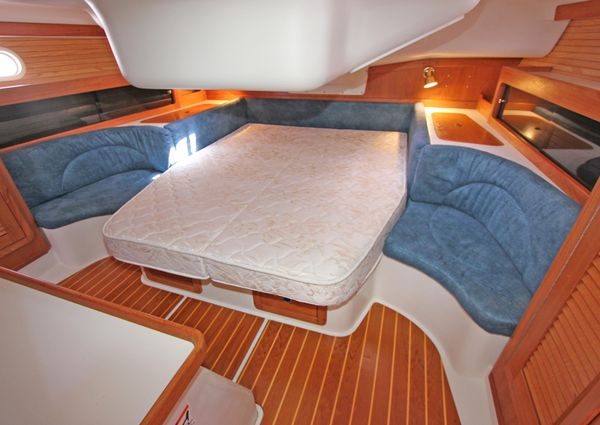 |
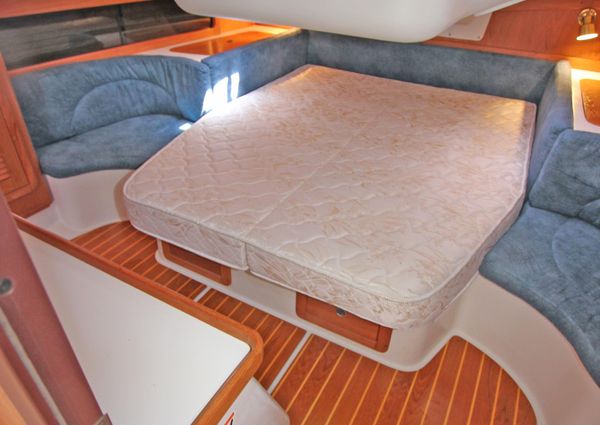 |
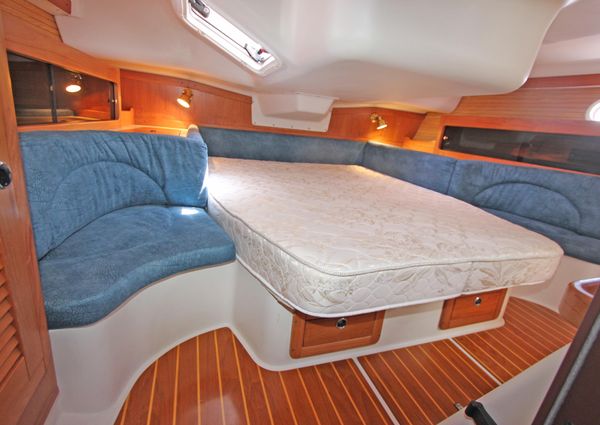 |
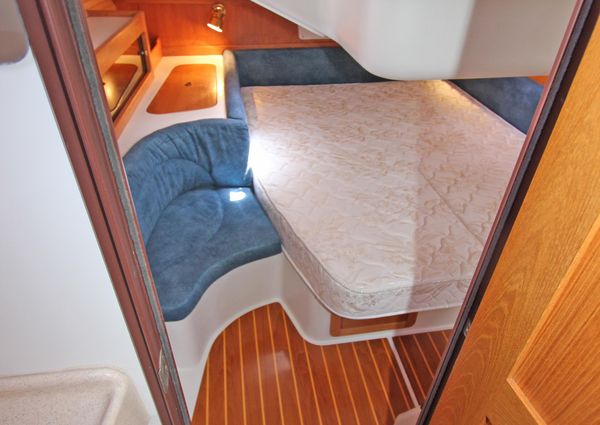 |
 |
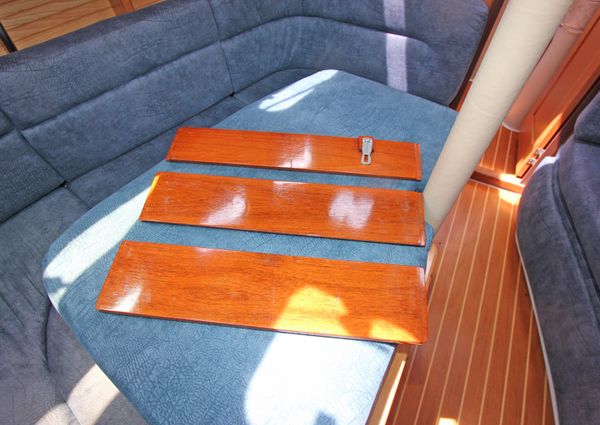 |
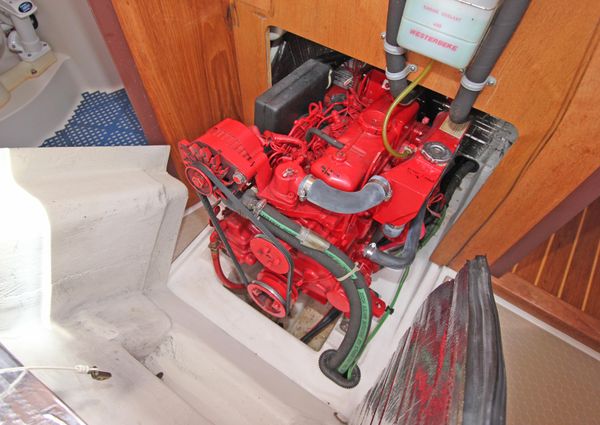 |
 |
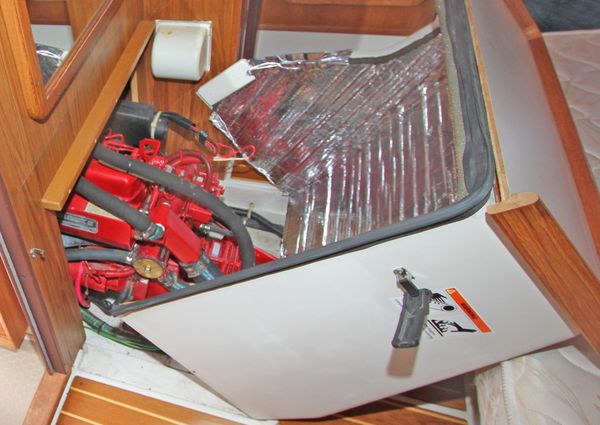 |
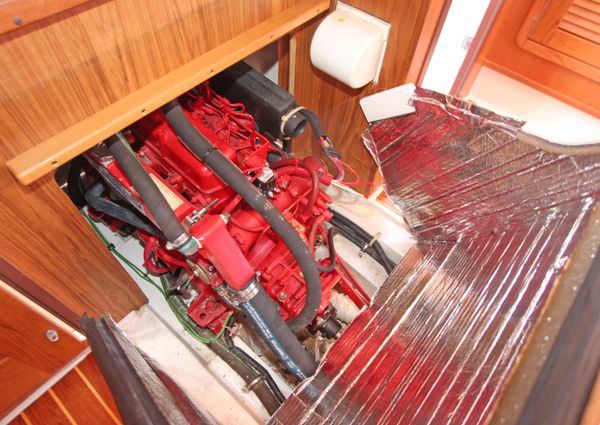 |
 |
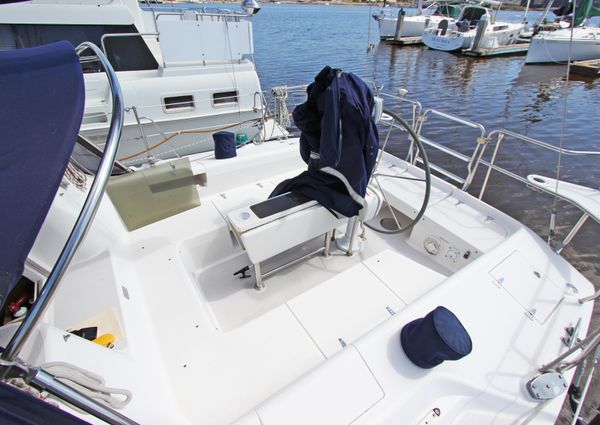 |
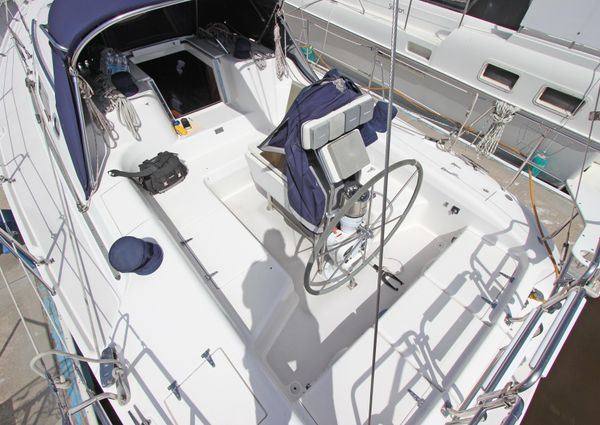 |
 |
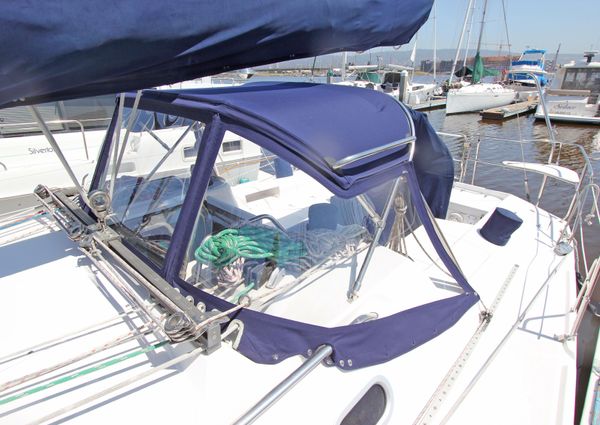 |
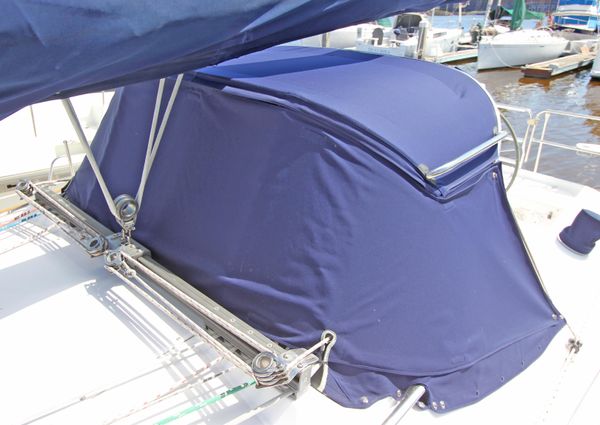 |
 |
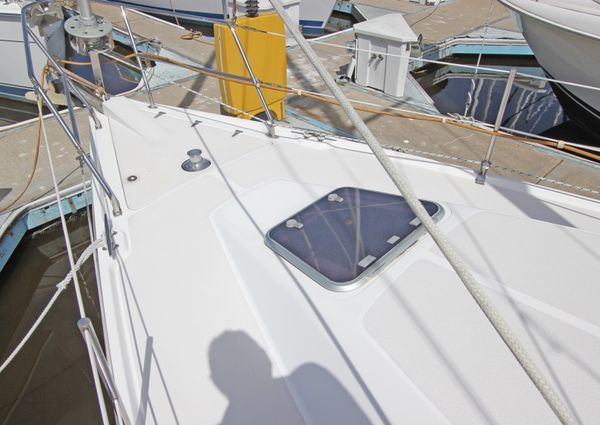 |
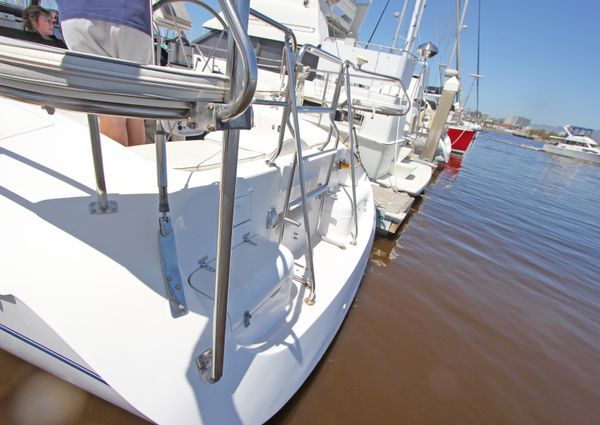 |
V-berth forward with in-suite sink, hanging locker and large opening hatch above. Step aft into salon with C-shaped convertible dinette port side and straight settee across starboard; settees are done in medium blue and show practically as new.
Continue aft to galley on port side with nav table and head across starboard; nav table has swing-out seat, head has separate stall shower and access from both salon and master stateroom.
Full beam master stateroom is far aft with queen centerline berth.
Note 6'7 headroom, abundance of light and air through a plethora of opening and fixed hatches and ports, teak & holly sole, interior is tastefully done and in excellent shape throughout.
L shaped galley with Corian countertops and twin polished stainless steel deep sinks with hot/cold pressure water (hot water heater is both engine and shore power fired), Princess three burner LPG gimballed stove with oven, top and front loading ice box with Adler-Barbour 12V refrigeration. Jabsco manual pump toilet (new in 2022).
12v DC / 110v AC. Thirty amp shorepower service, two 4D batteries (2022) in two banks with parallel switch, Heart inverter/charger.
Raytheon RL70 color chartplotter with 2kW radar overlay, Autohelm ST 5000 autopilot, Raytheon ST60 wind speed/direction indicator, Raytheon ST60 depth sounder/knot meter, Standard Horizon Matrix AIS/GPS VHF radio, 5" lighted Ritchie binnacle mounted compass.
Aluminum double spreader deck stepped mast with compression post and dacron standard main sail on aluminum boom with Dutchman system, #110 jib on Schaeffer 2100 roller furler. Two #54 Lewmar self-tailing winches, two #40 self-tailing winches, Garhauer oversized mainsheet with traveller, Garhauer rigid boomvang, inboard genoa track with heavy duty Garhauer adjustable cars.
FRP hull with one piece fiberglass deck and external lead standard draft fin keel secured with bolts, all to American Bureau of Shipping standards. Hull color is white with dark blue canvas, including beautiful custom offshore dodger (all new canvas and isinglass in June 2022), bottom last painted in late 2020.
Stainless steel bow pulpit, stainless steel stanchions with double lifelines, stainless steel stern pulpit with formed-in outboard "catbird seats" port and starboard, walk-through transom and stainless steel oversized folding swim ladder, stainless steel dingy motor hoist (not currently rigged). Edson binnacle with integral cockpit table, oversize Edson leather wrapped steering wheel.
Maxwell 12V vertical windlass, 35lb CQR anchor on bow roller with ample chain and line rode, seven mooring cleats.
Low time on Westerbeke four cylinder fresh water cooled diesel engine with Hurth tranny and 1" stainless steel shaft through bronze strut to three blade bronze propeller. Note excellent access to both front and rear of engine. Engine last serviced October, 2021, with almost no time clocked since.
When one of the biggest production sailboat builders in the world corrals top honors in a no-holds-barred fleet of extremely able contenders — including some candidates that fetch tens of thousands of dollars more than the winning yacht — it's time to take serious notice. So gather around for a look at the breakthrough 1997 Midsize Cruiser Of The Year, the Catalina 380.
The Catalina 380 was designed and built for weekend and vacation sailing with the added capability of an occasional offshore jaunt and extended sabbatical cruise. When the choices narrowed during final deliberations, the judges pondered a simple question: Of the 10 boats in the class ranging from 32 to 39 feet, which would they choose were they about to embark with their families on a no-nonsense voyage of 1,000 miles or so, culminating in a season aboard cruising Mexico or the Caribbean? The nod went to the larger of two impressive new Catalinas.
Size was of course a factor, but so too was value. The 380 is outfitted with a top-shelf list of gear and equipment. Among the standard components: Edson steering station, Schaefer roller furling, Adler Barbour refrigeration, Westerbeke 42-horsepower diesel engine, Maxwell windlass, Autohelm instruments for wind, speed and depth, Lewmar winches, Dutchman mainsail system, Z-spar mast, Garhauer blocks, and Spinlock rope clutches.
Catalina engineer Gerry Douglas and his design team canvased the opinions of previous Catalina owners, particularly those who'd owned and sailed models in the builder's 32- to 36-foot range. In the layout down below, the consensus was to eliminate the double heads featured in a previous Catalina 38 in favor of a big single head, to install more storage (three cedar-lined hanging lockers plus a dedicated wet locker), and to include a good navigation station (with its own comfortable, spring-loaded seat).
All pumps are centrally located and well labeled for trouble-free servicing. Engine access is outstanding, as good as it gets on a boat this size; a "wet area" for fuel and water filters contains leaks and contributes to a dry bilge. Anchor chain is led below by way of a straightforward chute that provides an excellent fairlead. Ventilation, by way of six cabin-top hatches and eight opening ports, is plentiful. In the interest of simplified maintenance, there's not a splinter of topside teak. With a very complete, fully indexed manual, it's a boat meant to be looked after by its owner — not by a high-priced service yard.
Construction is simple, but stiff and strong. A separate molded grid section is bonded into the solid fiberglass hull while it's still in the mold. The hull liner — sometimes relied upon for structural support in production building, but redundant on this boat due to its independent glass grid — is then installed over a layer of cavity-filling foam. It's a new process for Catalina, and one they're pleased with. The external lead keel is available in fin or wing options; it is secured with bolts to American Bureau of Shipping standards. The hull/deck joint consists of an external flange bonded and bolted in place and capped with a sturdy vinyl rub rail.
For the accommodation plan, there is a choice between dual aft cabins or a single aft stateroom; the latter version was entered in the Boat Of The Year competition. There are fiddles and bins and shelves in both cabins for storage and loose stuff. The dining table drops down within the wraparound settee to form an "emergency" double. The head, to starboard, is accessed either from the aft stateroom or from the central saloon. On the opposite side of the companionway, the galley revolves around a two-burner propane stove unit. There's plenty of counter space, a double sink and even an overhead "island" for cups and glasses.
Topside, the Catalina 380 is equipped with a deck-stepped, two-spreader rig available in standard or tall versions. The mainsheet and traveler are set up in a mid-boom arrangement forward of the companionway with the double-ended sheet eventually led aft to a pair of coach roof-mounted winches. Halyards and reefing lines also are brought aft to group the bulk of sail-handling chores in a safe, centralized location. The deck is arranged around a huge, uncluttered cockpit, the centerpiece of which is a fixed drop-leaf table for dining at anchor. A walk-through transom completes the back end of the boat.
Reading between the lines, the non-dimensional numbers for the 380 tell an interesting story. With a Displacement-to-Length ratio of 249, the Catalina registers a slightly more conservative figure than that generated by the venerable Valiant 40 (Disp/Length = 240), a design introduced almost 20 years ago and widely thought to signal the birth of the so-called "performance cruiser." But with a Sail Area/Displacement number of 17.3 for the tall rig — compared to the Valiant's 16.47 — there's plenty of compensating power in the sail plan. Perhaps most surprising, with a displacement of 19,500 pounds, the 380 is about the heaviest boat in this year's midsize class. Any way you look at it, this is a substantial vessel. Combine that with sprightly sailing qualities and generous interior volume and you've got a winner.
Source: Herb McCormick, Cruising World, March 1997, pg 96.
For anyone who still subscribes to the misconception that there’s no market for new sailboats, a visit to Catalina’s Woodland Hills plant in the Los Angeles area would be an eye-opener. The enormous factory building, originally set up to fabricate Saturn rocket engines for the Apollo moon flight program, consistently runs at full capacity—three shifts a day. At any given time there are approximately 60 cruising sailboats ranging in length from 27’ to 42’, making their way down the assembly lines in the main production area. Add another half-dozen hulls still in the molds—bearing in mind, too, that Catalina also operates a second, sizable facility in Florida (the Morgan plant in Largo)—and it becomes absolutely obvious that folks out there somewhere are buying new sailboats in serious numbers.
That “somewhere” for Catalina is primarily in North America, although the company also has a growing volume of sales throughout Europe and the Pacific Rim. Southern California—particularly San Diego and Los Angeles—represents Catalina’s traditional home market and still generates a substantial share of total sales. Although this firm does not disclose its sale figures, Catalina is generally considered to be the country’s largest sailboat manufacturer.
Catalina Yachts has remained under the close control of its founder, Frank Butler, for nearly a quarter century—no restructuring, no public stock issues. This fact alone makes the company a relative rarity in the boatbuilding industry, especially the notoriously volatile sailing sector.
“A small company with lots of employees,” is how Gerry Douglas, vice president and chief engineer at Catalina, sums up the overall structure of the firm. In effect, just three people—Butler, Douglas, and sales manager Sharon Day—“run” Catalina, whose work force averages around 350 people. Douglas and Day have teamed with Butler for over20 years and continue to play critical roles in the company’s development.
For such a lean management style to function successfully, Catlina’s officers must spend a great deal of time on the shop floor. Company meetings are held periodically to discuss policy, but informal conferences with key employees are day-to-day events. “The input of the people who are hands-on is always the most valuable,” Douglas explins, “and by and large, ours is a pretty free exchange.”
Historically, privately owned boatbuilding companies have tended to stay in business longer than those controlled by distant boards of directors. Clearly an intimate knowledge of boating, boatbuilding, and the many idiosyncrasies of the marine industry are prerequisites for success in this field. All the same, few privately owned production firms have managed to keep their doors open as long as Catalina, and even fewer have garnered anything approaching the market share that Catalina currently enjoys. But, there’s more to the Catalina story than micro-management and private ownership.
The Production Line
Catalina offers few surprises in its construction techniques. The typical boat begins in conventional female molds with an isophthalic gelcoat and skin coat. Decks are generally cored with balsa and plywood, while hulls consist of a single-skin lamination of conventional roving and mat. More and more, however, knitted biaxials are being used for reducing panel weights and for local reinforcement, particularly in the performance-oriented Capri models as well as the Catalina “contemporary” series (C-250, C-270, C-320, and C-400).
A molded hull liner, or pan, defines the interior layout and helps stiffen the hull; a comparable overhead liner finishes the underside of the deck molding. In may models, the hull liner incorporates aluminum angles in way of the chainplates, and these, as well as the sprayed urethane icebox insulation, are installed before the liner is secured to the hull.
Liners are bonded into place while the respective hull and deck parts are still in the mold, by using a large number of metal weights strategically positioned to provide suitable clamping pressure. Vacuum-bagging is inappropriate for this application because substantial clamping forces are needed in contact areas, but none where the parts are separated by air spaces.
Meeting Southern California’s stringent air quality standards—currently the nation’s toughest—has created special challenges for the laminating department at Catalina. Styrene-suppressed resins are now the norm, requiring extra care to ensure reliable secondary bonds. Dibasic ester (DBE) has been substituted for acetone as the primary cleaning solvent, and 160’-tall high-velocity exhaust stacks propel fumes to an altitude of around 500’ to better disperse residual odors. In addition, although the plant as a whole runs 24 hours per day, gelcoat spraying and laminating are restricted to night hours. This is primarily an exercise in good neighbor relations—averting complaints from office workers in adjoining buildings—since volatile organics are held within legal limits.
At Catalina, hulls and decks link up quite early in the production sequence, often before engines, systems, and most wooden components have been installed. A corollary of this approach is that interior components must be designed to fit through the companionway. Not surprisingly, the companionway on most models is unusually large, a popular feature among owners in the mild California climate.
Unlike many other builders in the production sailboat field, Catalina favors the shoe-box type hull-to-deck joint for a majority of models up to 42’ in length and, despite occasional criticism from competitors, reports excellent long-term success with it. A strip of plywood sandwiched between the upper margins of the hull molding and hull liner serves as a sheer clamp to stiffen the joint area and to “hold” fastenings. The vertical overlap area is bonded with polyester putty and mechanically fastened using a combination of through-bolts and self-tapping screws. The largest boats in the product line have a more conventional horizontal flange joint, through-bolted and sealed with polysulfide.
Keels are external lead/antimony castings, held in place by embedded stainless bolts. Spade rudders with mechanical wheel sterring are common to almost all Catalinas; most of the Capri models have tillers.
In-House Subcontracting
Modern cruising sailboats incorporate all the mechanical, electrical, and plumbing systems found in aboard comparable power boats, and quite a bit more besides. Consequently, the glass parts make p a significantly smaller proportion of the total package in terms of both labor and cost. In addition to woodworking and upholstery (routinely handled in-house by many production boatuilders), Catalina performs the majority of its keel casting, sparmaking, rigging, shipping cradle fabrication. Metalwork, sailmaking, and canvaswork. Complex manufactured components such as engines, winches, and pumps are obtained from vendors, but in product areas where major new capital investment is not involved, there’s often money to be saved by making these items in-house rather than “outsourcing” them. Besides, Gerry Douglas cites the benefits of assured supply lines and reports that when purchasing “from the outside,” Catalina routinely cultivates several alternative sources for each key item.
The company’s model sail loft builds primarily “plain vanilla” Dacron mains and jibs—the working sails needed to get out on the bay. In fact, the great majority of Catalina buyers are daysailors and coastal cruisers who use these sails as the backbone of their inventories. Even those with racing aspirations generally appreciate the factory sails for cruising and casual use. Similarly, the Catalina spar shop fabricates straightforward masthead rigs with swaged-terminal 1X19 wires. The more sophisticated, tapered masts seen on certain models, though, are purchased from outside sources.
Stainless steel pulpits, stanchions, and other deck fittings are fabricated at a separate but nearby facility. Dealers have been especially appreciative of the robust stainless frames supplied with Catalina’s factory-built dodgers, because they’re visibly superior to the lightweight aluminum frames prospective customers are accustomed to seeing. In this case, in-house sub-contracting provides a built-in sales advantage at minimal added cost.
Although most production builders cut their own plywood components and teak trim, Catalina has taken its woodworking a step further. In addition to a substantial woodshop in the factory itself, there’s a 30,000-sq-ft facility nearby where stock is processed and subassemblies prepared. Again, this provides opportunities for product differentiation. For example, cabin soles are plywood-based, but are faced with teak and holly approximately 1/8” thick. A salesman can readily point out the aesthetic and practical advantages of this construction, which contrasts well with the thin veneer floors used by many competitors.
Product Development
According to Douglas, whose multiple roles at Catalina include that of head designer, “It’s absolutely vital to build what the customer wants and not what you as an industry insider might want.” He points out that dramatic, leading-edge technology attracts media attention, but the average family sailor has a much more conservative perspective.
The starting point for each new design is a “wish-list notebook” in which Douglas records suggestions from boat owners. Butler, Day, and Douglas all spend a good deal of time attending owners’ meetings, and boat shows. Douglas calls it “anecdotal market research,” and despite the informality, it has obviously worked extremely well for Catalina. As a result of such input, the C-320, for example, features a cockpit locker large enough to accommodate bicycles.
As mentioned earlier, most Catalina boats have “old-fashioned” masthead rigs (rather than fractional rigs), because the masthead configuration allows a generous sail area with a low center of effort. The company’s design team believes this combination ensures respectable performance in key light-air markets such as Southern California, without making the boat too tender for an inexperienced sailor to enjoy on a breezy day.
With regard to styling, most Catalina products might be described as modern but staid: that is, they look the way the average sailor today expects a sailboat to look. Critics may say the designs are bland and unimaginative, but as Douglas notes, “It’s important that the boat should not seem silly in a couple of years.” Catalina’s so-called contemporary models incorporate such Eurostyle elements as wide sterns, enclosed aft cabins, and head compartments positioned amidships. Nevertheless, in terms of execution, these details are rather understated, a distinct contrast with many, perhaps a majority of Catalina’s competitors.
The abundance of used boats is widely regarded as a major stumbling block for the sailboat industry, but in some respects Catalina has found ways to turn the situation to its advantage. By producing durable boats, providing good product support, and promoting class activities such as one-design racing, the company has cultivated customer loyalty and enhanced used-boat resale values. The narrowed gap between new product and used craft encourages, to some extent, the sale of new Catalinas. More important, depreciation lower than the industry average is frequently cited by owners as an important influencing factor in their buying decisions. Some have “bought up through the ranks” and are now on their third or fourth Catalina.
In harmony with the principle of long-term product support, four “classic” Catalina models have received makeovers during the past three years. In each case, displacement, rig, and immersed hull form were left untouched, so the new boats could join existing fleets for casual one-design racing. On the other hand, the decks and cabintops were retooled for a cleaner, more modern look; and the topsides toward the stern were flared considerably to provide extra interior volume for a contemporary aft-cabin layout. Cockpits were reconfigured to provide more space, improved seating comfort, and through-transom boarding.
The first model to receive this treatment was the C-30, a boat which has now sold over 6,500 units. Encouraged by the revitalization sales of the C-30, Catalina subsequently modernized the C-36 for ’94, and the C-28 and C-42 in ’95. In each case, by extending the market life of a popular model, the builder has profited, partly through sales, but also indirectly by preserving the resale value of existing boats.
Although Catalina is in compliance with California’s air-quality regulations, Douglas is concerned that anti-pollution standards are a moving target. In his view, good past performance by area manufacturers and fabricators is encouraging even more rigorous regulations for the future. Last year the Woodland Hills plant discontinued offering factory-applied antifouling paint in an effort to further reduce VOCs.
The Florida plant, of course, operates in another jurisdiction, and might conceivably represent a form of manufacturing insurance in the environmental arena. Although Douglas denies this part of Catalina’s business plan, he remarks that “it’s better to have two of something.”
In broad terms, there are two distinctly different ways to approach the challenge of selling sailboats in the 90’s. The tack usually taken is to develop new, exciting designs that are different enough (and presumably superior) so that they will not compete directly with all those used boats.
Catalina takes the opposite tack. The company philosophy stresses continuity and constant, but gradual, product improvement. Existing models are rarely, and rather reluctantly, discontinued; even then, the company makes an effort to maintain support of these models by providing replacement parts and giving strong encouragement to class associations. This strategy works for Catalina thanks to long-fostered brand loyalty, along with an ability to manufacture dependable boats very economically, so the cost premium associated with buying new does not become too great an impediment to sales.
Although conservative alongshore sailors are its bread-and-butter buyers, Catalina enjoys the resources to explore market opportunities in other branches of the sport. One recent addition to the line, for example, is the C-250, a water-ballasted trailerable. Another, currently undergoing development and slated for introduction this summer, is the Capri 24, a high-performance sports boat with an asymmetrical spinnaker set from a retractable bowsprit. In each case, Catalina is moving fairly cautiously into a market area where other manufacturers have demonstrated that sales potential exists.
Since its beginnings in 1972, Catalina has grown from a small boatbuilder serving the local Southern California market to major manufacturer with worldwide dealings. Product exports have increased rapidly in the ‘90s thanks to strong foreign currencies and a growing reputation for good value. With dealerships in the United Kingdom, continental Europe, Japan, Australia, Singapore, and Puerto Rico generating sales, Catalina’s prospects for further penetration of overseas markets look bright.
By cultivating customer loyalty, mainstream appeal, and a moderately priced product that ages gracefully, Catalina Yachts has not merely survived, but succeeded. It’s no surprise therefore, that Douglas is upbeat about the future of recreational sailing. As he puts it, “We’re always guardedly optimistic. We hope for the best, but we’re not naïve enough to depend on it.” Homespun philosophy, perhaps, but a sentiment the marine industry as whole can take to heart.
Sven Donaldson, Professional Boatbuilder, June/July 1995, pg. 34.
The Company offers the details of this vessel in good faith but cannot guarantee or warrant the accuracy of this information nor warrant the condition of the vessel. A buyer should instruct his agents, or his surveyors, to investigate such details as the buyer desires validated. This vessel is offered subject to prior sale, price change, or withdrawal without notice.